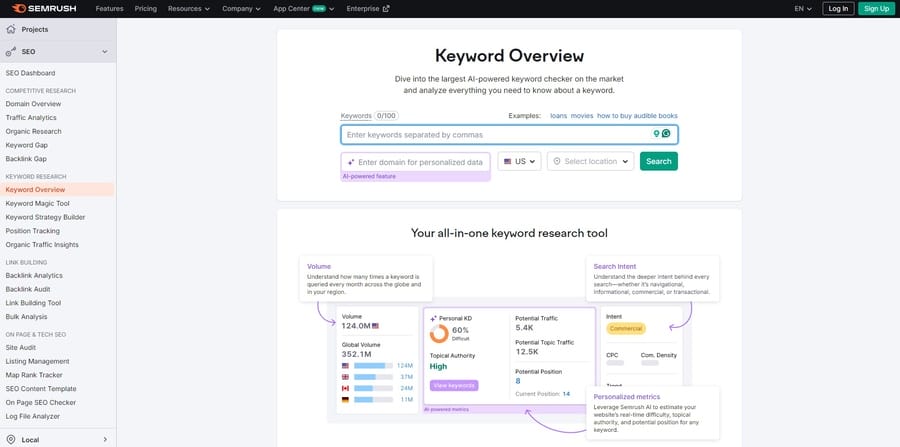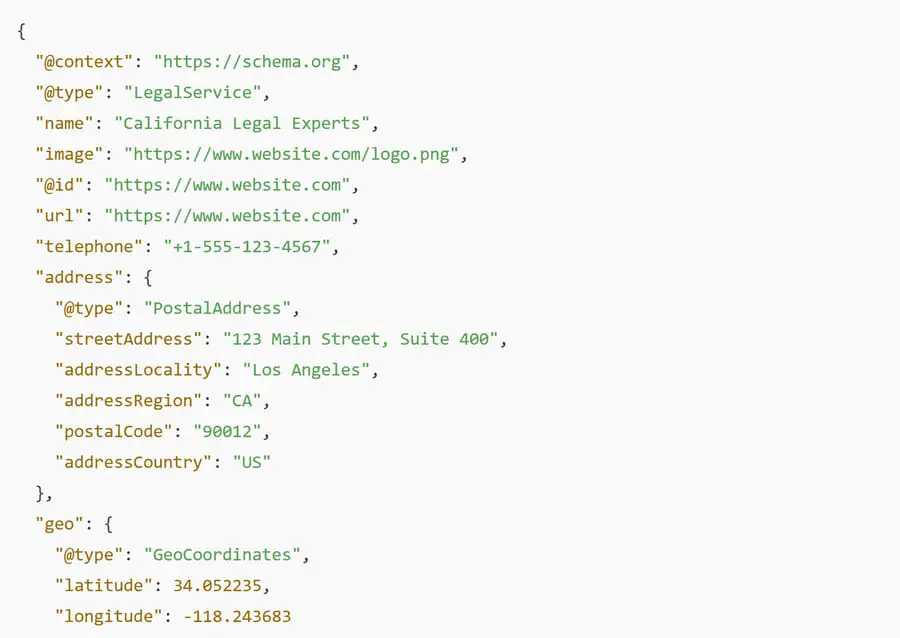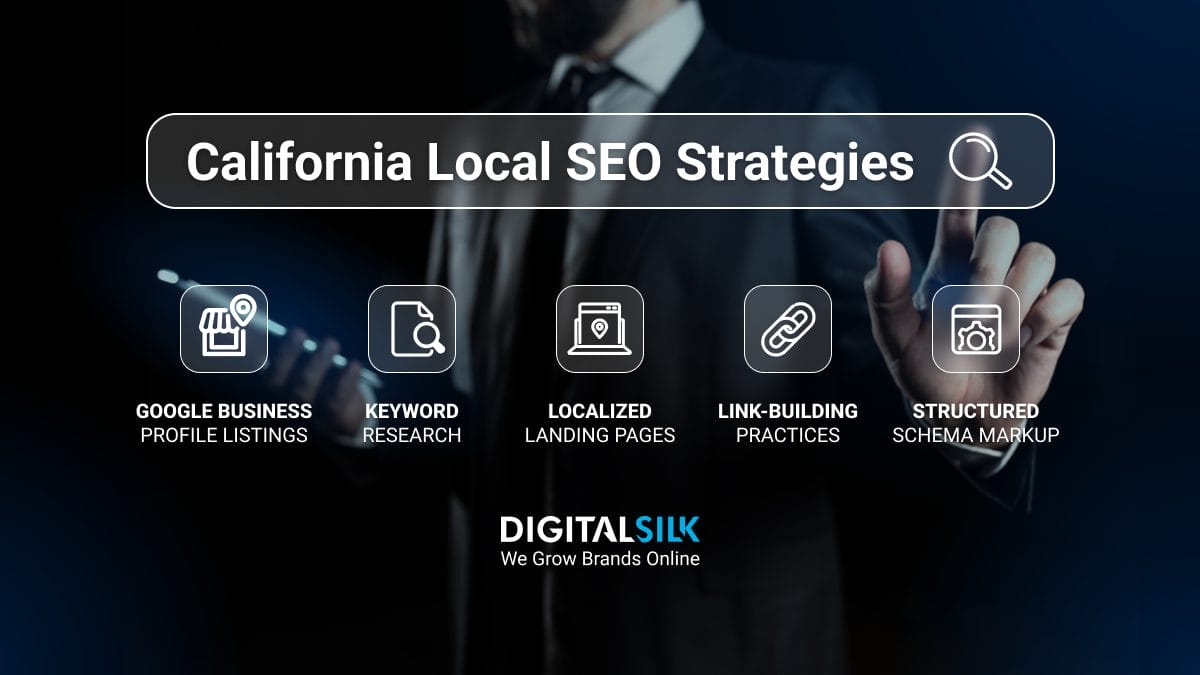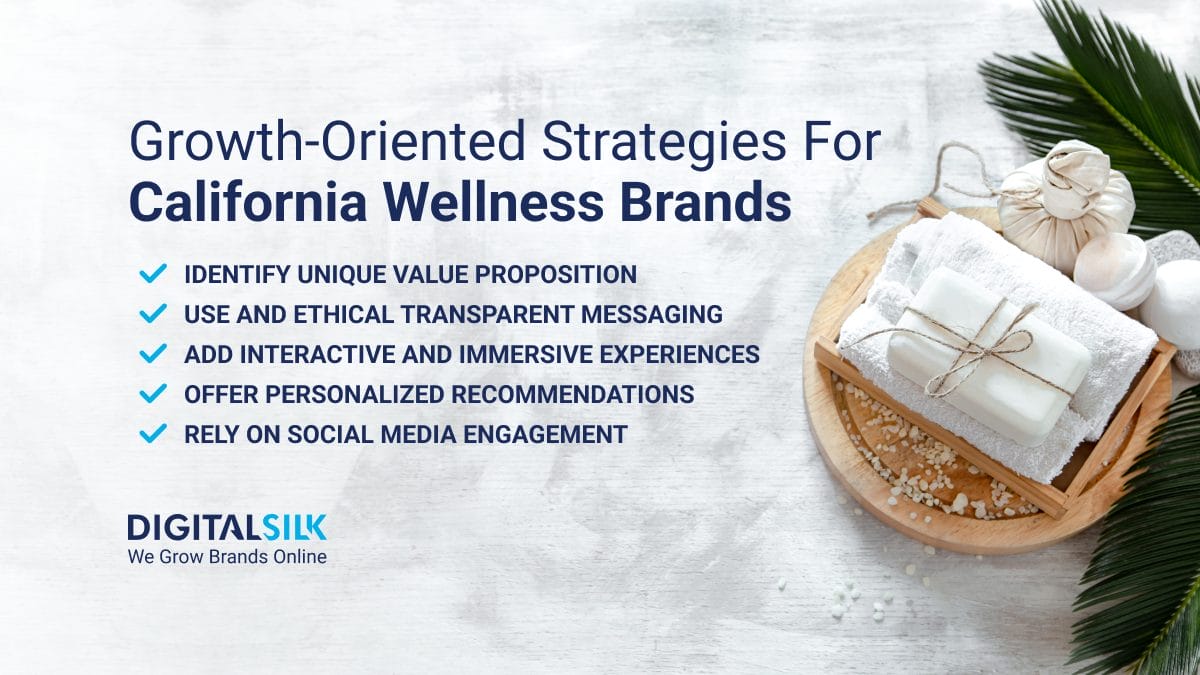SEO Strategy: Key Highlights
-
SMART goals power performance: Experts agree that setting clear, KPI-aligned goals remains key to effective SEO in 2025.
-
Know your audience: Search success starts with understanding user intent, behavior, and needs across the funnel.
-
Strategy = content + technical SEO: Combine intent-driven content with strong technical foundations to rank and scale.
The search engine optimization services market is projected to grow from $90.35 billion in 2024 to $106.9 billion in 2025 — proof that more companies are investing heavily in organic visibility.
But for most, that investment fails to translate into results — out of 1.1 billion websites online today, a staggering 96.55% get zero traffic from Google.
The remaining 3.45% succeed because they treat SEO as a long-term growth engine powered by data, precision and adaptability.
In this post, we’ll explore the essential steps to creating an SEO strategy that aligns with modern search algorithms, drives qualified traffic and delivers measurable business outcomes in 2025 and beyond.
Step 1. Define Your SEO Goals And Audience
Setting up a successful SEO strategy demands two core foundations:
- Clearly defined objectives
- Thorough understanding of your target users
Unlike short-term marketing campaigns, SEO planning requires strategic vision and specific metrics to track progress over months, not days.
1. Set Measurable SEO Goals
Most SEO tactics fall short before they even start — not because teams lack initiative, but because the goals behind them are too vague to drive meaningful execution.
Saying you want “more traffic” or “better rankings” is like saying you want more revenue — without specifying how, from where or by when.
You should set SMART goals — Specific, Measurable, Achievable, Relevant and Time-bound — to turn abstract outcomes into concrete targets your team can pursue.
For example, “increase traffic” becomes “grow organic traffic by 25% by improving rankings for commercial keywords on core product pages.”
The gap between goal setting and goal achievement is wider than most leaders expect.
While 74% of marketers say they set specific marketing goals, only 49% actually achieve them.
That disconnect often stems from poor goal design — goals that aren’t backed by the right resources, timelines or key performance indicators (KPIs).
You should choose metrics that directly support your business objectives:
- Rank improvements for target keywords
- Organic traffic growth percentages
- Conversion rate increases from organic visitors
- Number of indexed pages generating traffic
- Growth in non-branded search traffic
The achievability of your goals requires honest assessment. Evaluate your available resources, competitive landscape and current market positioning.
If you’re entering a saturated market without technical support or content depth, targeting modest growth on mid-intent keywords may deliver better returns than aiming for top rankings out of reach.
2. Understand Your Target Audience’s Search Behavior
Over 8 billion searches are made on Google every day.
Many of them come from people trying to solve a problem, make a decision or compare solutions — and some of those searches should be leading to you.
But they won’t if you don’t understand what your audience is typing into the search bar and what they expect to find when they do.
Yet only 42% of marketers have definitive data on their audience.
That means most teams are building content and campaigns without knowing how their buyers think or behave in search.
Without that insight, it’s nearly impossible to create pages that match intent, earn clicks or convert traffic into return on investment (ROI).
Understanding your audience starts by analyzing them from multiple angles:
- Demographics: Age, gender, location, income
- Psychographics: Values, lifestyles, interests
- Behavioral patterns: How they search and interact with content
- Geographic factors: Regional search variations
Keep in mind that search intent shifts throughout the decision process.
Early searches tend to be informational, such as “what is enterprise SEO”, while later entries may signal action, such as “top B2B SEO agency for SaaS.”
If your content only speaks to one stage, you’ll miss the opportunity to move prospects through the funnel.
Study how Google displays search results to understand how it interprets intent:
- Featured snippets suggest the query is looking for a quick, direct answer
- “People also ask” sections reveal related questions users commonly explore
- Shopping results indicate a strong transactional or product-focused intent
If your content doesn’t match that expectation, it won’t get visibility.
| Focus Area | What To Look For | Why It Matters |
| Demographics | Age, location, role | Informs targeting and messaging |
| Psychographics | Values, pain points, decision drivers | Helps frame content that resonates |
| Behavior | Search habits, page interaction | Guides content format and funnel placement |
| Geography | Regional phrasing, local demand | Affects keyword strategy and localization |
| Intent Signals | Informational vs. commercial vs. transactional | Aligns content to buyer stage and query type |
| SERP Features | Snippets, “people also ask”, shopping habits | Shows how Google interprets the search — your content should match |
| Market Shifts | Changes in search trends over time | Keeps strategy relevant as behavior evolves |
Step 2. Conduct Keyword And SERP Research
Once you know who you’re targeting, the next step is figuring out exactly what they search for and how Google ranks those queries.
1. Use Keyword Tools To Find Opportunities
Keyword research isn’t just about what people are searching for — it’s about whether those searches are worth competing for.
Two-word search terms make up 40% of all queries, followed by one-word searches at 19.46%, which means much of the volume lies in short, high-intent phrases.
The right platforms help you focus on what matters:
- Google Keyword Planner is built for paid search, but it offers forecasting and volume estimates that translate well into organic strategy. It’s free, straightforward and especially useful when you’re targeting commercial intent.
- SEMrush gives you visibility into which keywords drive traffic to your competitors, how their rankings change over time and where gaps exist that you can exploit. It’s particularly useful for evaluating keyword difficulty against your domain’s current strength.

When using these tools, look for keywords that strike the right balance — not so competitive that they’re out of reach, but not so obscure that they drive no meaningful traffic.
2. Analyze Search Intent Behind Keywords
Ranking for a keyword means nothing if the intent behind it doesn’t match what your page delivers.
Someone searching “best SEO tools” isn’t looking for a beginner’s guide — they’re comparing options.
Search intent typically falls into four categories:
- Informational – the user is learning (“how to create an SEO strategy”)
- Navigational – they’re trying to reach a specific site or page (“Semrush login”)
- Commercial – they’re comparing solutions before a purchase (“best SEO tools”)
- Transactional – they’re ready to buy or take action (“buy Ahrefs subscription”)
52.65% of all searches are informational, while 32.15% are navigational.
This means that more than 80% of search activity isn’t revenue-ready — it’s research-driven.
If your SEO strategy only focuses on transactional keywords, you’re entering the conversation too late.
That way, you miss the chance to shape perception early, build trust and guide prospects toward your solution before they even start comparing vendors.
3. Study Top-Ranking Pages For Content Patterns
Google uses over 200 factors to determine which pages deserve to rank — but you don’t need to reverse-engineer all of them.
The faster route is to study what’s already showing up on page one.
This approach gives you direct insight into how Google interprets a query and what it currently considers the best answer.
Focus on patterns across top results:
- Format – Are they guides, comparisons, checklists or expert commentary?
- Depth – Do they skim the topic or go deep with examples and subtopics?
- Media – Are videos, visuals or charts consistently included?
- SERP Features – Are snippets, “People also ask” boxes or video results appearing?
When analyzing competitors’ content, look for gaps you can fill with your own unique insights or approach.
| What To Analyze | What To Look For | Why It Matters |
| Format | Guides, comparisons, checklists, expert analysis | Reveals how users prefer to consume content for that query |
| Depth | Surface-level vs in-depth with examples and subtopics | Shows how comprehensive your content needs to be complete |
| Media | Use of videos, visuals, charts or interactive elements | Enhances engagement and matches content to user expectations |
| SERP Features | Presence of snippets, “people also ask”, videos | Signals how Google interprets intent and what formats it prioritizes |
Step 3. Build A Strategic SEO Content Plan
After discovering what your audience is searching for, how do you transform those keywords into content that ranks?
A strategic content plan serves as your roadmap, ensuring every blog post, landing page and resource has a clear purpose and aligns with your users’ search behavior.
1. Map Keywords To Content Types
The foundation of effective content strategy begins with matching each keyword to its most appropriate format based on user intent.
Different search queries require specific content types:
- Product/service pages for transactional keywords
- Comparison pages for commercial investigation terms
- How-to guides for informational searches
- Resources and tools for engagement-focused keywords
When mapping keywords, prioritize terms with the best “keyword opposition to benefit” ratio — those with manageable difficulty yet high business value.
You should organize this mapping in a detailed spreadsheet that tracks target URLs, primary keywords, secondary variations and content status.
This systematic approach ensures your content creation efforts focus on opportunities with the highest potential return rather than randomly targeting keywords without strategic direction.
2. Create Topic Clusters And Pillar Pages
Topic clusters represent a structured approach to content organization that strengthens your website’s topical authority and maximizes conversions.
To implement topic clusters effectively:
- Identify core topics relevant to your business and audience
- Create a comprehensive pillar page covering broad aspects of each topic
- Develop cluster content addressing specific subtopics
- Link cluster pages to the pillar page and vice versa
- Continuously expand your clusters as you identify content gaps
The pillar page acts as your content hub, guiding users toward more specific resources while cluster pages delve deeper into individual subtopics and link back to the main pillar page.
3. Balance Evergreen And Trending Content
Structured content is the top-performing SEO campaign strategy, accounting for 16.7% of what drives measurable results.
Evergreen topics build lasting visibility and authority, while timely content captures short-term attention when interest peaks.
Striking the right balance is what turns content into a consistent growth channel — not just a publishing habit.
70% of your content should focus on evergreen topics that remain relevant year after year, while 30% can target trending topics that generate immediate interest.
Step 4. Optimize On-Page And Technical SEO Elements
Technical SEO forms the foundation of your organic visibility strategy and increases brand awareness through data-driven solutions.
1. Boost Site Speed And Mobile Experience
Page speed isn’t just a technical detail — it directly impacts rankings, bounce rates and conversion paths.
On average, the main content of a website loads in just 1.3 seconds. If yours takes longer, you’re already behind.
To improve technical performance where it matters most:
- Upgrade from shared hosting to reduce server delays that slow down crawlability and indexation
- Compress large image formats to reduce load time without sacrificing quality
- Enable browser caching so returning users don’t load the same assets repeatedly
2. Craft Compelling Meta Titles And Descriptions
Meta descriptions are often your first — and only — chance to influence a searcher’s decision to click.
But here’s the catch: Google rewrites them 60–70% of the time.
This isn’t arbitrary either — if your original description doesn’t match the query, is too long, or lacks substance, Google replaces it with what it thinks is more relevant — usually by pulling snippets from your page.
You can improve the odds of your version being used — and boost click-through rates — by:
- Creating unique descriptions for each page
- Keeping text between 150-160 characters to avoid truncation
- Incorporating primary keywords naturally
- Adding soft calls-to-action like “See how it works” or “Unlock your advantage”
3. Build A Strategic Internal Linking Structure
Internal links aren’t just for navigation — they shape how search engines understand your site and decide which pages matter most.
A thoughtful structure helps pass authority to key pages, shortens the path for users and makes crawling more efficient.
Think in terms of architecture, not just links:
- Start from the top — your homepage should connect to core service or category pages
- Each of those should link to relevant subpages — this keeps depth manageable and signals relationships
- Use clean, descriptive URLs (e.g., example.com/services/seo/local) to help both users and Google make sense of where they are
When done right, internal linking turns scattered content into a connected system that’s easier to navigate, index and rank.
4. Ensure Complete Crawlability And Indexing
Before your pages can rank, they need to be found.
That starts with crawlability and indexing — if Google can’t access or understand a page, it doesn’t exist in search.
Follow these best practices to avoid costly indexing gaps:
- Link all important pages through your internal structure to avoid orphaned content
- Don’t block JavaScript, CSS or HTML files that affect how your pages are rendered
- Submit an XML sitemap in Google Search Console to support full discovery of your URLs
| Action | Why It Matters |
| Connect all key pages via internal links | Google finds pages by following links |
| Allow important pages to be crawled | Blocking core assets can prevent proper rendering |
| Submit a complete XML sitemap | Supports more consistent discovery and indexing |
5. Add Schema Markup For Enhanced Results
Schema markup provides explicit signals about page meaning using standardized code to help search engines understand content context.
Sites using structured data have measured up to 35% increased visits and 82% higher click-through rates compared to standard search results.
Below is an example of a schema markup for a local law firm in California:

6. Implement Canonical Tags For Duplicate Content
Duplicate content dilutes ranking signals across multiple URLs instead of concentrating authority on a single definitive page.
Add canonical tags to specify your preferred version when similar content exists at different URLs.
For instance, if both “example.com/shoes” and “example.com/shoes?color=red” display essentially the same information, add a canonical tag pointing to your preferred URL.
This consolidates ranking power and prevents wasted crawl budget on duplicate pages.
Step 5. Develop A Scalable Link Building Strategy
41% of marketers say link building is the hardest part of SEO strategy development — and it shows. It’s time-consuming, often unpredictable and easy to deprioritize.
But strong backlinks remain one of the clearest signals Google uses to evaluate authority.
1. Identify Backlink Opportunities From Competitors
At $361.44 on average, each backlink comes at a real cost — whether you’re paying for placement or investing time to earn it.
That’s why link building should start with data, not assumptions.
One of the most reliable ways to find quality opportunities is by analyzing who’s already linking to your competitors.
You can implement this competitive intelligence approach by:
- Use tools like Ahrefs or SEMrush to pinpoint direct competitors
- Review their backlink profiles to find domains linking to them but not to you
- Prioritize links from high-authority sites that influence rankings
- Identify which competitor pages attract the most links — and why
The goal is simple — understand what’s attracting credible links in your industry, then create something more useful or relevant to the same audience.
2. Use Digital PR And Guest Posting
Digital PR and guest posting aren’t isolated tactics — they’re two ways to build authority in places that already have it.
The goal is to earn trust, boost brand awareness and generate backlinks from credible sources without relying on transactional link building.
Some of the key best practices for PR include:
- Pitch timely stories tied to relevant trends, data or news cycles
- Provide original research, unique commentary or useful framing — not generic thought pieces
- Focus on outlets that speak to your customers or shape your industry narrative
- Keep the outreach targeted — quality over scale
While guest posting follows these steps:
- Build relationships with editors, not just contributor inboxes
- Offer content tailored to the publication’s voice and audience needs
- Avoid promotional writing — position your brand through insight, not self-reference
- Prioritize publications that influence buying decisions or peer perception
When used together, digital PR and guest posting help shape perception while earning links that move rankings — not because they’re optimized, but because they’re respected.
| Approach | Best Used For | Content Focus | Primary Outcome |
| Digital PR | Trend-driven or data-led outreach | Timely insights, original research | Brand credibility, media backlinks |
| Guest Posting | Blocking core assets can prevent proper rendering | Evergreen expertise, practical value | Industry trust, referral traffic |
3. Leverage Visual Content For Backlinks
Visual content earns links not because it looks good, but because it simplifies information others want to share.
When done right, it becomes a resource others reference by default.
Formats that consistently attract backlinks include:
- Infographics that break down complex ideas clearly
- Charts and graphs that help others visualize data
- Custom maps or visuals tied to geographic or industry-specific insights
- Original photos that get credited naturally when reused
To get results, optimize visuals for discovery, make them easy to embed with attribution and monitor for unlinked usage — those are links you’ve already earned, just not claimed.
Step 6. Adapt For AI And Future Search Trends
AI and SEO strategies now go hand in hand, as Google increasingly uses artificial intelligence to summarize and repackage content directly in search results.
To stay competitive, your approach must consider not just how content ranks, but how it’s interpreted and surfaced by AI.
1. Optimize For AI Overviews And Featured Snippets
AI Overviews now reach more than 1 billion people every month — placing synthesized, source-based answers at the very top of search results.
To be part of that layer, your content needs to be structured for clarity, not just keywords.
You can optimize your content for these features by:
- Creating clear, authoritative content backed by statistics and expert quotes
- Structuring information with descriptive headings to address search queries
- Targeting “no answer” queries where AI Overviews aren’t yet appearing
- Focusing on concise, factual statements that AI can easily extract
When users scan through your content they should:
- Quickly find the information they need
- Understand key points at a glance
- Discover value in both headlines and content details
2. Use Natural Language And Semantic Keywords
Since Google’s Hummingbird update, search engines have prioritized topic value and user intent rather than matching exact keywords.
Incorporate semantically related terms that help search engines grasp your content’s full meaning.
For instance, content about “SEO strategy” should naturally include related concepts like “keyword research,” “content planning” and “performance tracking.”
The stronger the context, the easier it is for search engines — and people — to trust what you’re saying.
3. Structure Content For Machine Readability
With 78% of organizations already using AI in at least one part of their business, your content is no longer just read by people — it’s interpreted, summarized and ranked by machines.
If it isn’t structured clearly, it’s less likely to rank, no matter how valuable it is.
You can optimize your content for AI interpretation by:
- Creating clear hierarchical structures with proper HTML heading tags (H1-H6)
- Breaking content into scannable sections with short paragraphs
- Using bulleted or numbered lists for easy information extraction
- Adding descriptive subheadings that summarize key points
To ensure your content performs well in both traditional search and AI-generated results, focus on creating content that answers user questions clearly and thoroughly while maintaining a logical, hierarchical structure.
Step 7. Track, Test And Improve Your SEO Performance
Even the most meticulously planned approaches require ongoing analysis to identify what works and where adjustments are needed.
1. Monitor Keyword Rankings And Traffic
Traffic and rankings are easy to measure — but harder to interpret without context.
High search volume means little if it doesn’t connect to the right audience and top rankings don’t matter if they’re for terms that never convert.
You can evaluate search engine performance through these key indicators:
- Position changes for target keywords
- Month-over-month organic traffic growth
- Pages per session and time on site metrics
- Conversion rates from organic visitors
- Non-branded search visibility
2. Use Google Search Console And Google Analytics
Search Console and Google Analytics (GA4) don’t just show traffic — they reveal what’s working and where visibility is being wasted.
Click-through rate (CTR) was named the leading performance metric by 9.2% of SEO professionals and Search Console is the most direct way to track it.
The most effective SEO professionals regularly check:
- Pages receiving traffic increases or decreases
- Keywords triggering impressions but few clicks
- User behavior patterns after landing on your site
- Technical issues flagged in Search Console
- Core Web Vitals performance metrics
3. Adjust Strategy Based On Performance Data
Data-driven decision making requires turning insights into action.
By routinely analyzing performance data, you can refine your approach, investing more in what works while adjusting or abandoning tactics that underperform.
You can follow these steps to enhance your SEO strategy:
- Set up weekly performance monitoring routines
- Create custom reports that align with your key business objectives
- Establish alert thresholds for significant traffic or ranking changes
- Document strategy adjustments based on performance insights
- Compare your metrics against industry benchmarks
Implementing a robust tracking system gives you the insights needed to continuously refine your SEO strategy, respond to algorithm updates and capitalize on emerging opportunities in your market.
Create An Effective SEO Strategy With Digital Silk
Successful SEO strategies demand both immediate technical optimization and long-term strategic vision.
Your ability to interpret data, recognize shifting search patterns and adjust your strategy accordingly determines your organic success.
Digital Silk’s experienced team of in-house SEO and digital marketing specialists follow the latest best practices to drive organic traffic, increase SERP visibility and boost user engagement.
As a recognized web design agency, our services include:
- SEO services
- Digital marketing
- Social media marketing
- PPC advertising
Our team takes a proactive and consultative approach to each project, offering transparent communication at every stage to deliver measurable results.
Need help developing a results-focused SEO strategy?
Contact our team, call us at (800) 206-9413 or fill in the Request a Quote form below to schedule a consultation.
"*" indicates required fields









